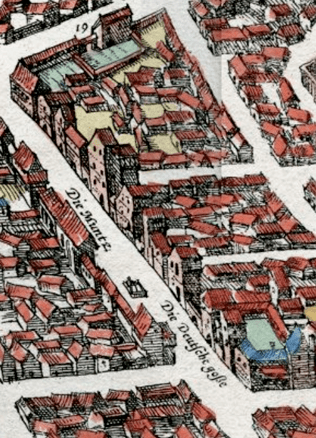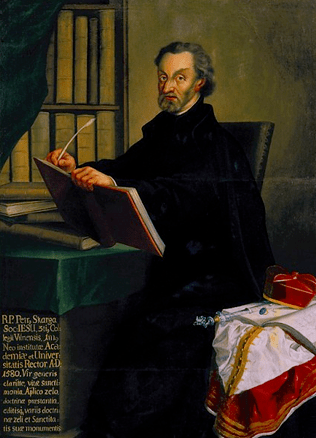Catholic Ruler, a Patron of Orthodox Churches
Acts issued by Grand Dukes of Lithuania begin with the words: “By the grace of God, the Grand Duke of Lithuania and the ruler of Rus’, Samogitian and other lands…” Whenever the representatives of the Jagiellon dynasty became kings of Poland too, the introductory part would be extended to “By the grace of God, the King of Poland and the Grand Duke of Lithuania.” It has been used so often that one might think that it is nothing more than a simple and formal combination of words to be repeated on every occasion. The formulation, however, expresses the essence of the mediaeval concept of the ruler. People genuinely thought at that time that God alone granted the power of rule to every king and grand duke. Certain countries even tended to believe that their ruler possessed otherworldly powers. Some people in France and England were sure that their king was able to heal their ailments by simply holding hands over them. Taking care of his subjects’ wellbeing and of the security of the Church and faith, and implementing justice were the main tasks for every ruler. Sigismund I the Old has embraced it all in a single phrase when he said: “I am a ruler of sheep and goats”. The king used that short ironic sentence to outline his main duty, the responsibility to be equally caring about all of his subjects. Sheep and goats mean Catholics and Orthodox in that phrase. All the rulers of the Grand Duchy of Lithuania were Catholics, while their country officially was a Catholic state, but with large numbers of inhabitants adhering to the Orthodox faith. The subjects, in turn, had to look after the wellbeing of their ruler, because his good health was key to the health of the entire state as the ruler embodied the state.
A two-way bond existed, because the ruler had certain commitments before his subjects, while they also had duties before the ruler.
The clergy had a duty to pray for the ruler. Their prayers kept him safe from hazards and illnesses; they ensured long life, pleaded for mercy and safeguarded him from sins. The ruler would pay them back in all sorts of presents, including plots of land and expensive liturgical items. Generosity was a privilege of a ruler that the subjects expected to experience.
Earthly boons for heavenly reconciliation
Hierarchs and clergy of the Orthodox Church lived in the GDL feeling they are the citizens of the same country submitting to the same Catholic ruler, who follows Christian values while taking care of all of his subjects. They have a duty to pray for the ruler, while he must protect the Orthodox Church. The funding acts (the ones that give land) issued by the grand dukes of Lithuania to the Orthodox churches and monasteries include the obligation for clerics to pray for the soul of the ruler. These kinds of statements are still rare in the middle of the 15th century, but they become a rule from the early 16th century onwards as all the funding acts issued to the Orthodox churches and monasteries invariably feature the phrase “And pray God the Lord on my behalf.” The verbal tradition found its place in written documents and became the norm of everyday life during the reign of Sigismund I the Old.
Tatars led by Meñli I Giray, a khan of the Crimean Khanate, devastated Kiev in 1482. Orthodox churches and monasteries, built in the 10th and 11th century, were extremely badly damaged, because the invaders sought for their riches. They ravaged the Golden-Domed Monastery of St. Michael the Archangel, the name of which refers to its golden dome that gave a start to the tradition of gilding cathedral domes throughout the whole Rus. Tatars stripped the gilded sheets of metal off its cupolas. Kiev Pechersk Lavra, the spiritual cradle of the Ruhenian monkhood, faced similar destiny, just like the Monastery of Christ the Saviour and the Monastery of St Nicholas. Archimandrites and hegumens of these monasteries turned to the ruler for help. The rebuilding of churches and monasteries got under way after two Grand Dukes of Lithuania, Casimir IV Jagiellon and Alexander I Jagiellon, had allocated funds for that. Their respective act, however, does not include the formulation “And pray God the Lord on our behalf.” The reconstruction of the Golden-Domed Churched inside the Monastery of St Michael the Archangel was finished in 1523. It was then that Makari, the hegumen of the monastery, wrote to Sigismund I the Old asking him to allow restore the community of monks and recreate the monastery buildings next to the church.
The ruler gave the monastery some land to earn money for rebuilding the monastery and put the obligation before the future community of monks to pray God the Lord of their behalf.
The ruler has also provided financial assistance to the Monastery of the Kiev Pechersk Lavra; his act of foundation includes the urge to deliver “more prayers to God the Lord on our behalf.” The land-giving act issued for the Monastery of Christ the Saviour in Kiev features an analogous formulation, “And pray God the Lord on our behalf.” An obligation to “pray God the Lord on our behalf” has been put before Misail Shcherbina, the hegumen of the monastery. The Monastery of St Nicholas received sizeable plots of lands as well to support its community of monks and to take care of the soul of the ruler. Sigismund I the Old, who approved in 1516 the donation acts issued by Alexander I Jagiellon, noted that his predecessor had done that in order to take care of his soul; therefore Sigismund obliged the monks to continue praying for his late brother: “His majesty the late King Alexander gave all of that so that you pray for him.”
Dynastic continuity in monks’ prayers
The ruler wanted the clerics pray not only for him but for other representatives of the dynasty too. The appropriate practice has been put in place by the voivodes of Kiev appointed by the ruler. Adrzej Nemirowicz, the Catholic noble who gave some land to the abovementioned monastery, put an obligation before the community of monks in 1534 to “pray unto God our Lord for his majesty the king.” Regional dukes never included that kind of obligations in their acts of foundation, but the voivodes appointed by the ruler always took care that the beneficiaries prayed for the ruler.
The ruler also used to take care that people attending the churches belonging to regional Orthodox dukes prayed for him. In the document confirming the donation of lands to the Church of Holy Trinity in Mstislavl by the Orthodox local duke Jonas Lengvenaitis, the representative of the side branch of the Gediminid dynasty, the ruler reminded the congregation in 1544 to “pray unto God the Lord on our behalf according to the old rite and the foundation and donation acts by the dukes of Mstislavl.” The dukes of Mstislavl from the Lengvenaitis family have never mentioned any obligation to pray for the ruler in their documents of foundation. Exploiting the tradition, Sigismund I the Old introduced prayers for the ruler in that same church. That kind of obligation has been included in the legal settlement issued by Alexander I Jagiellon on 5 June 1499 and related to the lands owned by the St Sophia Cathedral in Polotsk. The document reads: “As the lands have been received [by the St Sophia Cathedral], the parishioners must pray every year for Duke Skirgaila and our ancestors.” Appointed by his brother Jagiełło, Skirgaila was his vicegerent in Lithuania from 1387 to 1392. He ruled in Polotsk from 1386 to 1393. The tradition to pray for Skirgaila, as for the representative of the Gediminid dynasty, emerged in the late 14th century; it transformed into prayers for all members of the dynasty by the late 15th century. Skirgaila’s successors fostered the tradition. Sigismund I the Old reminded the residents of Polotsk of it in 1544 when he was judging a legal dispute between the bishop of Polotsk, on the one side, and the local nobility and the clergy, on the other. “In return for the proceedings, they [the residents of Polotsk] would pray for the dead, burn candles and celebrate masses, and now they are unable to pray properly for the souls of dukes of Polotsk.”
The introduction of praying practice was a deliberate action throughout all Ruthenian lands of the GDL.
In the act confirming the transfer of lands owned by the nobility to the Holy Trinity Monastery in Smolensk, Sigismund I the Old committed the monks to praying “for us unto God the Lord.” The same formulation has been used when donating a mill to the St. Nicholas Church that stood inside the city castle. Referring to the clergymen of the St Boris and St Gleb Church in Navahrudak, the city which became a permanent residence of the metropolitans of Kiev in the second half of the 15th century, Sigismund I the Old called them “the clergymen who pray for our soul” in the acts of donation.
Catholic king, the head of the Orthodox Church in the GDL
The commitment to pray for the ruler and for the late representatives of the dynasty has helped to build the apprehension of the long-lasting common historical past among people living in the Rutheninan lands, which, in turn, has made the state stronger and more united. The aforementioned practice was key in establishing the idea that the Catholic ruler was the head of the Orthodox Church in the GDL.
Do You Know?
The tradition that the secular ruler is also head of the Church, who is in charge of the administration of the Church, who appoints the top hierarch of the Church and who summons councils of the Church, takes root in Byzantium. The practice, when the ruler becomes both the political leader and head of the Church, bears the name of caesaropapism. Ruthenians have followed the tradition since the Christianisation in 988; they were well aware of it. Grand dukes of Lithuania would also make use of the tradition, while Sigismund I the Old has enforced it and turned it into daily practice.
The ruler united the Christian nation comprising Catholics and Orthodox.
This is why the metropolitans of Kiev, appointed by the ruler, would pray for him. Josif Soltan, the metropolitan of Kiev, consecrated the monastery in Suprasl built by Aleksander Chodkievicz and gave it some land before asking the monks “to pray for the ruler and his health.” The understanding that the ruler is the embodiment of the Christian community becomes obvious in the testament of Simon Czeplejewski, the clergyman of the Church of the Miraculous Cross of the Lord in Volkovysk: “[They] will be obliged to pray for his majesty the king and the members of the Council of the Nobility and for all the Orthodox Christians unto God the Lord.” The rulers introduced caesaropapism in the Orthodox Church of the GDL in the early 16th century. The obligation of praying for the ruler was projected into the future as a never ceasing tradition.
Remigijus Černius



